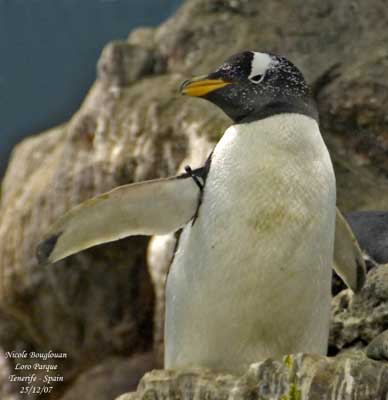
Gentoo Penguin
Pygoscelis papua
Sphenisciforme Order - Spheniscidae Family
BIOMETRICS :
Length : 76 à 81 cm ; Weight : M: 5,5 à 8,5 kg – F : 5 à 7,5 kg.
PHYSICAL DESCRIPTION:
Gentoo Penguin is the largest penguin after Emperor and King Penguins.

Adult has blackish plumage on the upperparts, and whitish rump. Black tail is fairly long. Flippers are black, bordered with white.
Underparts are white.
Head is black with conspicuous triangular white patch above each eye, and extending to the crown. Chin and throat are black.
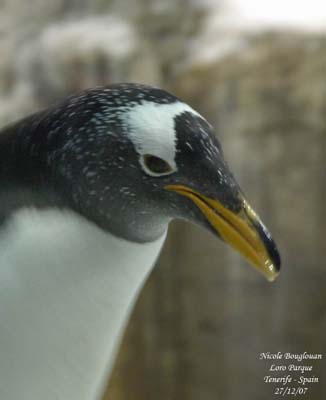
Straight bill is orange-yellow with black culmen and black base in lower mandible. Eyes are dark brown with narrow orange-yellow eye-ring. Powerful legs and webbed feet are dull orange-yellow.
Both sexes are similar, with female smaller than male.
Juvenile has smaller white patches on the head, and sometimes grey throat. At hatching, the chick is covered in pale brown down. Young can breed at two years of age.
We can find two subspecies:
P.p. papua
P.p. ellsworthii, which is smaller in size and bill.
VOICE: SOUNDS BY XENO-CANTO
Gentoo Penguin is mostly silent, but it can become noisy during the nesting period, uttering a kind of braying sound, as a darkey.
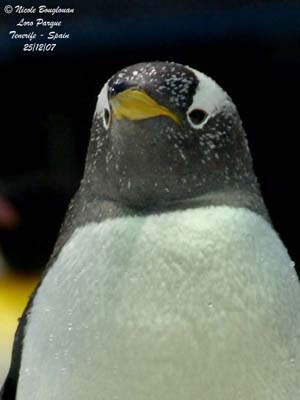
HABITAT:
Gentoo Penguin breeds on rocky coasts and prefers flat grounds with scattered vegetation. It avoids ice, and frequents bare hillsides and beaches. It spends most of time fishing at sea.
RANGE:
Gentoo Penguin lives in Antarctica and sub-Antarctica islands. It breeds mainly on the Kerguelen Islands, on South Georgia and in Falklands.
BEHAVIOUR:
Gentoo Penguin feeds mainly on krill, but it also consumes fish, crustaceans and squid.
It catches its preys by pursuit underwater. For finding krill, it is able to dive to 50 metres down, and for fish, it can dive down to 130 metres and more. It usually forages close to the colony, in order to feed frequently the chicks. Gentoo Penguin is highly marine.
Gentoo Pinguin is gregarious and lives in colonies including smaller groups. They also are gregarious at sea, and form large flocks to help in catching preys.
Young penguins gather in creches one month after hatching, and adults go off to search for food. Young learn to swim together, entering into the sea in shallow water, in order to paddle close to the shore. Some waves higher than others make them run back up to the beach, with flippers outstretched and almost afraid by this new element.
Gentoo Penguin is partially migratory, and sub-Antarctic birds seem to be sedentary. Populations of Antarctic Peninsula migrate.
During the breeding season, the male performs some displays in order to establish the nest-site and to attract a female. Then, female selects a male and its territory. The pebbles for the nest are attractive for the female, and during the displays, the male offers her a nice stone in order to obtain her favours.
Gentoo Penguin may be territorial, according to the colony size.
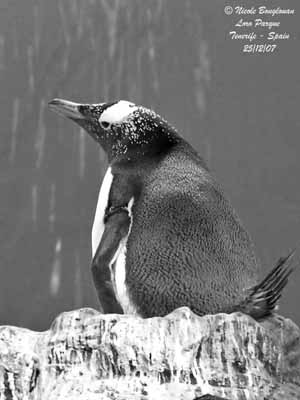
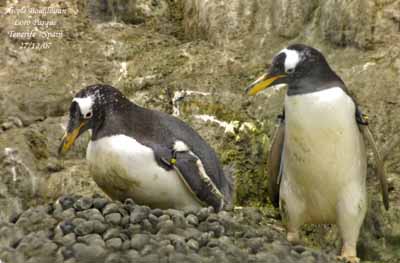
MOVEMENTS:
Gentoo Penguin does not fly, but it walks and even runs on the ground and in spite of its clumsy attitude, it runs easily on land.
But Gentoo Penguin is made for swimming. It can dive at 20 to 200 metres depth. It can swim rapidly underwater, and it is the fastest swimming bird, reaching speeds of 35 km per hour.
REPRODUCTION:
Breeding season occurs from spring to autumn, but variation is considerable with the locality. Gentoo Penguin breeds in small colonies, sometimes with other species. These colonies can move from year to year, and penguins breed at some distance from the last year, at about 150 metres. This behaviour could be a kind of defence against parasites, or a way for allowing the vegetation to grow again. Such numbers of birds leave heavy accumulation of excreta.
Nest-site is on the ground, in rocky uninhabited shores or among clumps of vegetation. Gentoo Penguin builds its nest with pebbles and tail feathers from old moults. It is composed of several hundreds of pebbles, forming a circular pile of stones, with some grass or moss. Nest materials are strongly guarded, and disputes occur between penguins which steal stones from other nests.
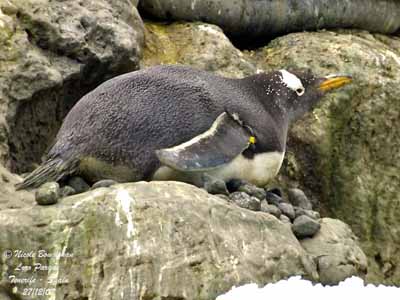
Female lays two eggs of about 500 gr each, three days apart from each other. Incubation lasts about 31 to 39 days, shared by both parents.
In this species, usually the two chicks may survive. They remain at nest for about one month. Then, they join the crèche, forming flocks which offer advantages of defence against predators and climatic conditions, and adults can go off in search of food.
Young fledge between 85 and 115 days after hatching (60 to 80 days in southern populations). They are fed by parents for 5 to 50 days more.
This species can lay again in replacement of a failed clutch, and a pair usually produces two chicks per year.
DIET:
Gentoo Penguin feeds mainly on krill, but also on fish and squid. It catches its preys by diving underwater and pursuit. Gentoo Penguin dives deeper than other species, avoiding competition for food resources. It swallows the prey head first, and while swimming.
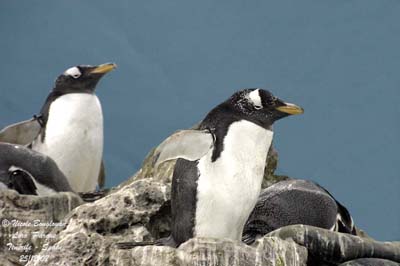
PROTECTION / THREATS / STATUS:
Gentoo Penguin has a wide range, but this species has suffered from human threats and habitat loss over the last century. Populations seem to be more stable at this moment, thanks to conservation efforts.
Gentoo Penguin, as other species, is preyed upon by skuas, falcons, gulls, petrels and feral cats which take the eggs and attack the chicks.
Adults are taken by Leopard seals, and nests are destroyed by Elephant seals when they move through the colony.
An estimate (Lynch 2012) suggests an increase of the population, especially in the south of the range. The global population is estimated to number 387,000 pairs (314,000 pairs in 1993).
But currently, the Gentoo Penguin is classified as Near Threatened.
Fr: Manchot papou
All : Eselspinguin
Esp : Pingüino Juanito
Ital : Pinguino Papua
Nd : Ezelspinguïn
Russe : папуанский пингвин
Text and photographs by Nicole Bouglouan
Sources :
HANDBOOK OF THE BIRDS OF THE WORLD vol 1 by Josep del Hoyo-Andrew Elliot-Jordi Sargatal - Lynx Edicions - ISBN: 8487334105
Animal Diversity Web - (University of Michigan Museum of Zoology)
Antarctic Connection (Thomas Hutchings – Gloria Hutchings)
Les Manchots (François Durand)
New Zealand birds and birding (Narena Olliver)
Welcome to the wonderful world of penguins (Dr. Lloyd Davis)
Wikipedia (Wikipedia, The Free Encyclopedia)